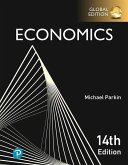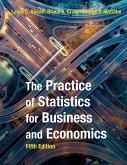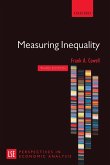61,99 €
inkl. MwSt.
Versandkostenfrei*
Erscheint vorauss. 17. September 2025
Melden Sie sich
hier
hier
für den Produktalarm an, um über die Verfügbarkeit des Produkts informiert zu werden.

31 °P sammeln
- Broschiertes Buch
For principles of economics courses. All-time best-selling principles of economics title Principles of Economics is trusted for its clear, thorough and complete coverage of how market economies function. Covering both macro- and microeconomics perspectives, it balances economic theory, institutional material and real-world examples, with emphasis on the art and science of economic thinking. The 14th Edition features streamlined chapters, revised problems and all-new macro data through 2023. It adds 23 new Economics in Practice boxes with recent research and analysis. In MyLab, new assignable…mehr
Andere Kunden interessierten sich auch für
![Economics, Global Edition Economics, Global Edition]() Michael ParkinEconomics, Global Edition71,99 €
Michael ParkinEconomics, Global Edition71,99 €![Econometric Analysis, Global Edition Econometric Analysis, Global Edition]() William H. GreeneEconometric Analysis, Global Edition75,99 €
William H. GreeneEconometric Analysis, Global Edition75,99 €![The Practice of Statistics for Business and Economics (International Edition) The Practice of Statistics for Business and Economics (International Edition)]() Layth AlwanThe Practice of Statistics for Business and Economics (International Edition)85,99 €
Layth AlwanThe Practice of Statistics for Business and Economics (International Edition)85,99 €![Management Gurus, Revised Edition Management Gurus, Revised Edition]() Andrzej HuczynskiManagement Gurus, Revised Edition264,99 €
Andrzej HuczynskiManagement Gurus, Revised Edition264,99 €![Wirtschaftsmathematik für das Bachelor-Studium Wirtschaftsmathematik für das Bachelor-Studium]() Thomas ChristiaansWirtschaftsmathematik für das Bachelor-Studium29,99 €
Thomas ChristiaansWirtschaftsmathematik für das Bachelor-Studium29,99 €![MEASURING INEQUALITY THIRD EDITION MEASURING INEQUALITY THIRD EDITION]() Frank CowellMEASURING INEQUALITY THIRD EDITION56,99 €
Frank CowellMEASURING INEQUALITY THIRD EDITION56,99 €![Airport Systems, Second Edition Airport Systems, Second Edition]() Richard DeNeufvilleAirport Systems, Second Edition181,99 €
Richard DeNeufvilleAirport Systems, Second Edition181,99 €-
-
-
For principles of economics courses. All-time best-selling principles of economics title Principles of Economics is trusted for its clear, thorough and complete coverage of how market economies function. Covering both macro- and microeconomics perspectives, it balances economic theory, institutional material and real-world examples, with emphasis on the art and science of economic thinking. The 14th Edition features streamlined chapters, revised problems and all-new macro data through 2023. It adds 23 new Economics in Practice boxes with recent research and analysis. In MyLab, new assignable Economics in Practice videos featuring Emily Oster make economics relevant and relatable for students.
Hinweis: Dieser Artikel kann nur an eine deutsche Lieferadresse ausgeliefert werden.
Hinweis: Dieser Artikel kann nur an eine deutsche Lieferadresse ausgeliefert werden.
Produktdetails
- Produktdetails
- Verlag: Pearson
- 14. Auflage
- Erscheinungstermin: 17. September 2025
- Englisch
- ISBN-13: 9781292488479
- ISBN-10: 1292488476
- Artikelnr.: 73328508
- Herstellerkennzeichnung
- Pearson
- St.-Martin-Straße 82
- 81541 München
- salesde@pearson.com
- +4989541960460
- Verlag: Pearson
- 14. Auflage
- Erscheinungstermin: 17. September 2025
- Englisch
- ISBN-13: 9781292488479
- ISBN-10: 1292488476
- Artikelnr.: 73328508
- Herstellerkennzeichnung
- Pearson
- St.-Martin-Straße 82
- 81541 München
- salesde@pearson.com
- +4989541960460
About our authors Karl E. Case, who passed away in July 2016, was a Professor of Economics Emeritus at Wellesley College, where he taught for 34 years, serving several tours of duty as Department Chair. He was a Senior Fellow at the Joint Center for Housing Studies at Harvard University and a founding partner in the real estate research firm of Fiserv Case Shiller Weiss, which produces the S&P Case-Shiller Index of home prices. He served as a member of the Index Advisory Committee of Standard and Poors, and on the Academic Advisory Board of the Federal Reserve Bank of Boston. Professor Case received his BA from Miami University in 1968, spent three years on active duty in the Army and received his PhD in Economics from Harvard University in 1976. Professor Cases research was in the areas of real estate, housing and public finance. He authored or coauthored five books, including Principles of Economics, Economics and Tax Policy and Property Taxation: The Need for Reform, and published numerous articles in professional journals, focused on real estate markets and prices. Chip, as he was known to his many friends and colleagues, contributed to this textbook throughout its many editions. In his honor and with respect for his substantial contributions to the text and the discipline of economics, his coauthors plan to keep his name on the text for all future editions. Ray C. Fair is Professor of Economics at Yale University. He is a member of the Cowles Foundation at Yale and a Fellow of the Econometric Society. He received a BA in Economics from Fresno State College in 1964 and a PhD in Economics from MIT in 1968. He taught at Princeton University from 1968 to 1974. Professor Fair has taught introductory and intermediate macroeconomics at Yale since 1974. He has also taught graduate courses in macroeconomic theory and macroeconometrics. Professor Fairs research has primarily been in the areas of macroeconomics and econometrics, with particular emphasis on macroeconometric model building. He has also done work in the areas of finance, voting behavior and aging in sports. His publications include Macroeconomic Modeling: The Cowles Commission Approach (M.I.T. Press, 2024) and Predicting Presidential Elections and Other Things (Stanford University Press, 2012). Professor Fairs US and multicountry models are available for use on the Internet free of charge. Many teachers have found that having students work with the US model on the Internet is a useful complement to an introductory macroeconomics course. Sharon M. Oster, who passed away in June 2022, was the Frederic Wolfe Professor of Economics and Management and former Dean of the Yale School of Management. Professor Oster joined Case and Fair as a coauthor in the ninth edition of this book. Professor Oster had a BA in Economics from Hofstra University and a PhD in Economics from Harvard University. Professor Osters research focused on industrial organization. She worked on problems of diffusion of innovation in a number of different industries, on the effect of regulations on business and on competitive strategy. She published a number of articles in these areas and was the author of several books, including Modern Competitive Analysis and The Strategic Management of Nonprofits. Prior to joining the School of Management at Yale, Professor Oster taught for a number of years in Yales Department of Economics. In the department, Professor Oster taught introductory and intermediate microeconomics to undergraduates as well as several graduate courses in industrial organization. Beginning in 1982, Professor Oster taught primarily in the Management School, where she taught the core microeconomics class for MBA students and a course in the area of competitive strategy. Professor Oster also consulted widely for businesses and nonprofit organizations and served on the boards of several publicly traded companies and nonprofit organizations.
PART 1: INTRODUCTION TO ECONOMICS
1. The Scope and Method of Economics
2. The Economic Problem: Scarcity and Choice
3. Demand, Supply, and Market Equilibrium
4. Demand and Supply Applications
5. Elasticity
PART 2: THE MARKET SYSTEM
1. Household Behavior and Consumer Choice
2. The Production Process: The Behavior of Profit-Maximizing Firms
3. Short-Run Costs and Output Decisions
4. Long-Run Costs and Output Decisions
5. Input Demand: The Labor and Land Markets
6. Input Demand: The Capital Market and the Investment Decision
7. General Equilibrium and the Efficiency of Perfect Competition
PART 3: MARKET IMPERFECTIONS AND THE ROLE OF GOVERNMENT
8. Monopoly and Antitrust Policy
9. Oligopoly
10. Monopolistic Competition
11. Externalities, Public Goods, and Common Resources
12. Uncertainty and Asymmetric Information
13. Income Distribution and Poverty
14. Public Finance: The Economics of Taxation
PART 4: CONCEPTS AND PROBLEMS IN MACROECONOMICS
15. Introduction to Macroeconomics
16. Measuring National Output and National Income
17. Unemployment, Inflation, and Long-Run Growth
PART 5: THE CORE OF MACROECONOMIC THEORY
18. Aggregate Expenditure and Equilibrium Output
19. The Government and Fiscal Policy
20. Money, the Federal Reserve, and the Interest Rate
21. The Determination of Aggregate Output, the Price Level, and the Interest
Rate
22. Policy Effects and Cost Shocks in the AS/AD Model
23. The Labor Market in the Macroeconomy
PART 6: FURTHER MACROECONOMICS ISSUES
24. Financial Crises, Stabilization, and Deficits
25. Household and Firm Behavior in the Macroeconomy: A Further Look
26. Long-Run Growth
27. Alternative Views in Macroeconomics
PART 7: THE WORLD ECONOMY
28. International Trade, Comparative Advantage, and Protectionism
29. Open-Economy Macroeconomics: The Balance of Payments and Exchange Rates
30. Economic Growth in Developing Economies
PART 8: METHODOLOGY
31. Critical Thinking about Research
1. The Scope and Method of Economics
2. The Economic Problem: Scarcity and Choice
3. Demand, Supply, and Market Equilibrium
4. Demand and Supply Applications
5. Elasticity
PART 2: THE MARKET SYSTEM
1. Household Behavior and Consumer Choice
2. The Production Process: The Behavior of Profit-Maximizing Firms
3. Short-Run Costs and Output Decisions
4. Long-Run Costs and Output Decisions
5. Input Demand: The Labor and Land Markets
6. Input Demand: The Capital Market and the Investment Decision
7. General Equilibrium and the Efficiency of Perfect Competition
PART 3: MARKET IMPERFECTIONS AND THE ROLE OF GOVERNMENT
8. Monopoly and Antitrust Policy
9. Oligopoly
10. Monopolistic Competition
11. Externalities, Public Goods, and Common Resources
12. Uncertainty and Asymmetric Information
13. Income Distribution and Poverty
14. Public Finance: The Economics of Taxation
PART 4: CONCEPTS AND PROBLEMS IN MACROECONOMICS
15. Introduction to Macroeconomics
16. Measuring National Output and National Income
17. Unemployment, Inflation, and Long-Run Growth
PART 5: THE CORE OF MACROECONOMIC THEORY
18. Aggregate Expenditure and Equilibrium Output
19. The Government and Fiscal Policy
20. Money, the Federal Reserve, and the Interest Rate
21. The Determination of Aggregate Output, the Price Level, and the Interest
Rate
22. Policy Effects and Cost Shocks in the AS/AD Model
23. The Labor Market in the Macroeconomy
PART 6: FURTHER MACROECONOMICS ISSUES
24. Financial Crises, Stabilization, and Deficits
25. Household and Firm Behavior in the Macroeconomy: A Further Look
26. Long-Run Growth
27. Alternative Views in Macroeconomics
PART 7: THE WORLD ECONOMY
28. International Trade, Comparative Advantage, and Protectionism
29. Open-Economy Macroeconomics: The Balance of Payments and Exchange Rates
30. Economic Growth in Developing Economies
PART 8: METHODOLOGY
31. Critical Thinking about Research
PART 1: INTRODUCTION TO ECONOMICS
1. The Scope and Method of Economics
2. The Economic Problem: Scarcity and Choice
3. Demand, Supply, and Market Equilibrium
4. Demand and Supply Applications
5. Elasticity
PART 2: THE MARKET SYSTEM
1. Household Behavior and Consumer Choice
2. The Production Process: The Behavior of Profit-Maximizing Firms
3. Short-Run Costs and Output Decisions
4. Long-Run Costs and Output Decisions
5. Input Demand: The Labor and Land Markets
6. Input Demand: The Capital Market and the Investment Decision
7. General Equilibrium and the Efficiency of Perfect Competition
PART 3: MARKET IMPERFECTIONS AND THE ROLE OF GOVERNMENT
8. Monopoly and Antitrust Policy
9. Oligopoly
10. Monopolistic Competition
11. Externalities, Public Goods, and Common Resources
12. Uncertainty and Asymmetric Information
13. Income Distribution and Poverty
14. Public Finance: The Economics of Taxation
PART 4: CONCEPTS AND PROBLEMS IN MACROECONOMICS
15. Introduction to Macroeconomics
16. Measuring National Output and National Income
17. Unemployment, Inflation, and Long-Run Growth
PART 5: THE CORE OF MACROECONOMIC THEORY
18. Aggregate Expenditure and Equilibrium Output
19. The Government and Fiscal Policy
20. Money, the Federal Reserve, and the Interest Rate
21. The Determination of Aggregate Output, the Price Level, and the Interest
Rate
22. Policy Effects and Cost Shocks in the AS/AD Model
23. The Labor Market in the Macroeconomy
PART 6: FURTHER MACROECONOMICS ISSUES
24. Financial Crises, Stabilization, and Deficits
25. Household and Firm Behavior in the Macroeconomy: A Further Look
26. Long-Run Growth
27. Alternative Views in Macroeconomics
PART 7: THE WORLD ECONOMY
28. International Trade, Comparative Advantage, and Protectionism
29. Open-Economy Macroeconomics: The Balance of Payments and Exchange Rates
30. Economic Growth in Developing Economies
PART 8: METHODOLOGY
31. Critical Thinking about Research
1. The Scope and Method of Economics
2. The Economic Problem: Scarcity and Choice
3. Demand, Supply, and Market Equilibrium
4. Demand and Supply Applications
5. Elasticity
PART 2: THE MARKET SYSTEM
1. Household Behavior and Consumer Choice
2. The Production Process: The Behavior of Profit-Maximizing Firms
3. Short-Run Costs and Output Decisions
4. Long-Run Costs and Output Decisions
5. Input Demand: The Labor and Land Markets
6. Input Demand: The Capital Market and the Investment Decision
7. General Equilibrium and the Efficiency of Perfect Competition
PART 3: MARKET IMPERFECTIONS AND THE ROLE OF GOVERNMENT
8. Monopoly and Antitrust Policy
9. Oligopoly
10. Monopolistic Competition
11. Externalities, Public Goods, and Common Resources
12. Uncertainty and Asymmetric Information
13. Income Distribution and Poverty
14. Public Finance: The Economics of Taxation
PART 4: CONCEPTS AND PROBLEMS IN MACROECONOMICS
15. Introduction to Macroeconomics
16. Measuring National Output and National Income
17. Unemployment, Inflation, and Long-Run Growth
PART 5: THE CORE OF MACROECONOMIC THEORY
18. Aggregate Expenditure and Equilibrium Output
19. The Government and Fiscal Policy
20. Money, the Federal Reserve, and the Interest Rate
21. The Determination of Aggregate Output, the Price Level, and the Interest
Rate
22. Policy Effects and Cost Shocks in the AS/AD Model
23. The Labor Market in the Macroeconomy
PART 6: FURTHER MACROECONOMICS ISSUES
24. Financial Crises, Stabilization, and Deficits
25. Household and Firm Behavior in the Macroeconomy: A Further Look
26. Long-Run Growth
27. Alternative Views in Macroeconomics
PART 7: THE WORLD ECONOMY
28. International Trade, Comparative Advantage, and Protectionism
29. Open-Economy Macroeconomics: The Balance of Payments and Exchange Rates
30. Economic Growth in Developing Economies
PART 8: METHODOLOGY
31. Critical Thinking about Research







